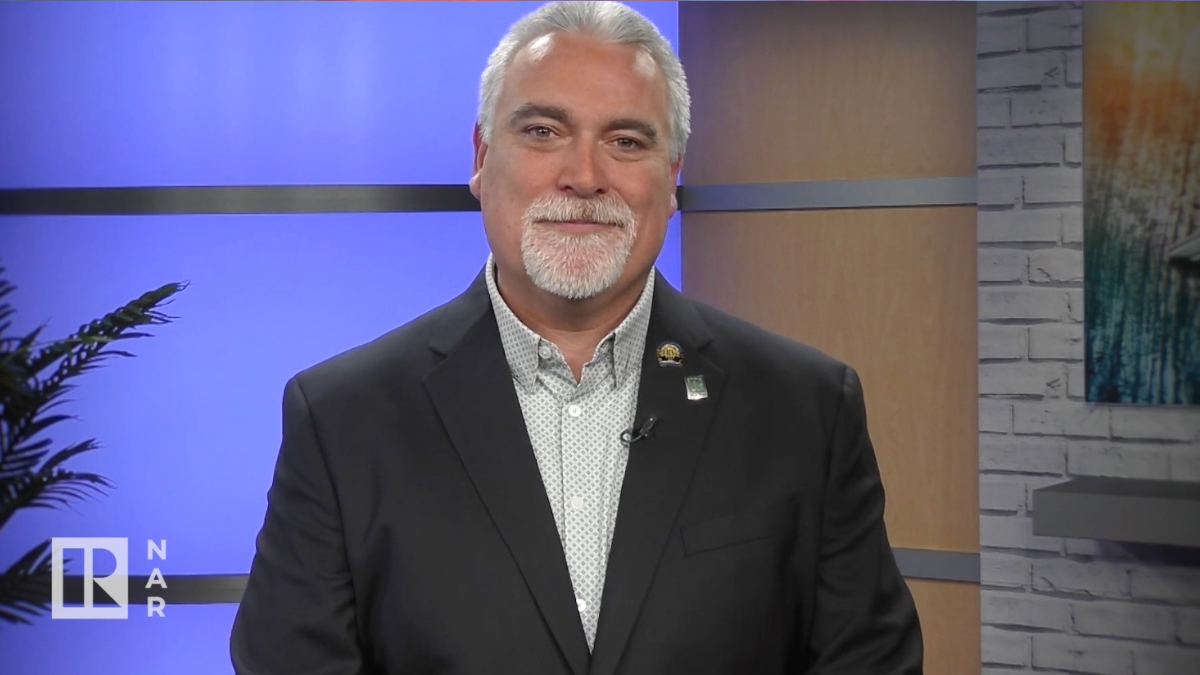
Nothing was off the table when National Association of Realtors (NAR) President Kevin Sears joined NextHome CEO James Dwiggins and chief strategy officer Keith Robinson on this week’s episode of their “Real Estate Insiders Unfiltered” podcast.
During the hour-long episode, they discussed everything from Sears’ reaction to assuming the role of president, his first three months on the job, NAR’s commission lawsuit settlement agreement, and changes he is working to enact within NAR and across the broader real estate industry.
Sears acknowledged that he is a “war-time” president, leading NAR through some of the biggest challenges it has faced in its 100-plus-year history. He noted that he has used his college experience as an NCAA Division 1 scholarship diver, as well as a stunt diver at summer amusement park shows, to help him into the right frame of mind to navigate these challenges.
“I used to do high dives from 75 feet; I used to get lit on fire and paid for it,” Sears said. “When I talk to people about my experience in that stunt diving show, one of the things that I learned through that is practice and repetition means a great deal. Trusting your fundamentals means a great deal and you are never quite prepared for the first time you get lit on fire. But what it taught me is not to panic, and that is a skill set that I think has served me very well in my leadership journey.”
While Sears’ involvement in Realtor associations began as soon as he received his real estate license in Massachusetts, thanks to the encouragement of his late father, his road to assuming the presidency this past January had quite a few twists and turns. In August 2023, Kenny Parcell resigned from the presidency due to a sexual harassment scandal, causing Tracy Kasper to step into the role. But Kasper’s tenure was short-lived as she resigned in early January 2024 due to blackmail threats.
Since assuming the role of president, Sears has worked to build upon some NAR initiatives that were started under Kasper, including the Culture Transformation Commission, which was set up in October and made up of Realtors, staff, and state and local members. The commission is working on recommendations for changes within the organization. Sears told Dwiggins and Robinson that the trade group will use these as it tries to prevent a repeat of the events that led him to be named president nearly a full year earlier than expected.
Early on in his tenure as NAR president, Sears announced that he would not be taking on any presidential initiatives during his term in office. During the podcast, he shed some light on this decision.
“When we find ourselves in a rut or a slump, the first thing we need to do is just stop, settle down and then get back to the basics, get back to the fundamentals,” Sears said. “I am not one for themes or singular presidential initiatives, so I want the staff to get back to basics, focus on the fundamentals and drive toward the core mission of our association, which I believe is to make our members more successful. Because if we make our members more successful, we’re going to be able to serve the consumer even better.”
Sears said that one of the ways he is trying to help the staff at NAR do their jobs is by improving the trade group’s communications.
“There was a vacuum in communication. And when there is a void, it gets filled and not always with the truth, the message that we want,” Sears said. “So, one of the things I asked the senior leadership to do was do a better job communicating.”
In an effort to seamlessly work to improve these areas, Sears noted that Nykia Wright, NAR’s interim CEO, has agreed upon request to extend her time at NAR through the end of 2024.
In addition to working on internal communications, Sears said everyone at NAR has been focused on improving their external communications, especially those with the media. While some of the frustration that media coverage has caused for NAR recently has stemmed from inaccurate information being shared in reports, it has also come from how the announcement of the commission lawsuit settlement agreement was handled.
On the podcast, Sears noted that all parties had agreed to an embargo on the news, but The New York Times broke the story an hour earlier, leading Sears to suggest that the plaintiffs’ attorneys leaked the news.
“We had a comms plan for the settlement,” Sears said. “We had an embargoed press release … and we were abiding by what was agreed to in the settlement. We had to call an audible. So, that put us on the defensive.”
Sears discussed the monetary settlement as well as the terms that NAR negotiated in its agreement. Additionally, he revealed that NAR was always considering a settlement, despite its public vows to appeal the Sitzer/Burnett jury verdict.
“There were settlement conversations before the trial, during the trial and after the trial,” he said.
As for the $418 million NAR now has to come up with to contribute to the settlement fund, Sears said it is working with financial experts “to figure out how exactly we’re going to meet our financial obligation for this settlement.”
While Sears acknowledged that the financial cost of the settlement may cause some changes within the organization — including the possibility of streamlined operations — he did not say whether membership dues would increase to cover costs, nor did he suggest that NAR would be unable to meet its financial commitment.
“We’re going to have to look at that and carefully say, ’Where do we take from, and how can we make sure that the association can continue to provide the resources, tools, programs and advocacy that our members have come to expect?’” Sears said.
Dwiggins, Robinson and Sears also discussed how changes to cooperative compensation may impact homebuyers using Federal Housing Administration (FHA) and U.S. Department of Veterans Affairs (VA) loans.
According to Sears, NAR has received confirmation from Department of Housing and Urban Development Commissioner Julia Gordon that per FHA policy, if sellers continue to pay buyer broker commissions and fees as a manner of state and local laws or customs, and if these expenses are reasonable in amount, the existing policy would not treat those payments as interested party contributions. But a letter that NAR sent to the VA has remained unanswered.
Sears added that the level of advocacy among top officials is one of the major things setting NAR apart from Mauricio Umansky and Jason Haber’s upstart trade group, the American Real Estate Association.
“One of the things I actually love about that thought process is, first of all, I don’t think they’d be able to compete with us on just the advocacy alone,” Sears said. “But competition makes us better. On a daily basis, we’re interacting with our competitors, and it makes us better. So, any opportunity for us to get better, I welcome it.”
Despite the myriad challenges he and NAR are facing, it was clear that Sears is feeling positive about the future.
“I’m always a look-out-at-the-horizon kind of guy,” Sears said. “I am encouraged by where I think we can get to through all of this.”
Related
Discover more from reviewer4you.com
Subscribe to get the latest posts to your email.




